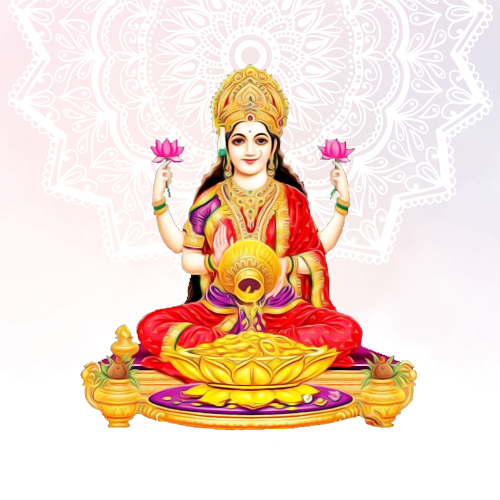
Maha Laxmi Pooja
Mahalaxmi Pooja, dedicated to Goddess Lakshmi, the deity of wealth, prosperity, and fortune, is a significant ritual in Hindu households. It is performed especially during festivals like Diwali, Navratri, and Fridays, which are considered auspicious for worshiping Lakshmi.
Steps and Procedure of Mahalaxmi Pooja
-
Preparation:
- Clean the house thoroughly, as cleanliness is vital to welcome Goddess Lakshmi.
- Decorate the altar with flowers, rangoli, and lights.
- Place an idol or picture of Goddess Lakshmi on a clean platform or in the pooja room.
- Arrange all the necessary items like kalash (pot), coconut, mango leaves, incense sticks, lamp, kumkum (vermilion), turmeric, rice, flowers, fruits, sweets, and coins.
-
Setting Up the Altar:
- Place a clean cloth on the altar.
- Put the kalash filled with water in the center and cover it with mango leaves.
- Place a coconut on top of the kalash and wrap it with a red cloth.
-
Invocation:
- Light the lamp (diya) and incense sticks.
- Chant a prayer or mantra to Lord Ganesha to remove any obstacles in the pooja. You can use the mantra "Om Gan Ganapataye Namah."
-
Main Rituals:
- Dhyana (Meditation): Meditate on Goddess Lakshmi, visualizing her form and attributes.
- Avahana (Invocation): Invite Goddess Lakshmi to the altar by chanting the Avahana mantra.
- Asana (Offering a Seat): Offer a seat to the goddess using flowers or rice grains.
- Padya (Washing the Feet): Symbolically wash the feet of the goddess using a few drops of water.
- Arghya (Offering): Offer water mixed with sandalwood paste, turmeric, and kumkum.
- Achamana (Purification): Offer water for sipping to purify.
- Snana (Bathing): Offer water, milk, honey, and ghee as a symbolic bath to the goddess.
- Vastra (Clothing): Offer new clothes or a piece of cloth to the idol or picture.
- Abharana (Jewelry): Adorn the idol with jewelry and ornaments.
- Gandha (Fragrance): Apply sandalwood paste or perfume to the idol.
- Pushpa (Flowers): Offer flowers and garlands.
- Dhoopa (Incense): Light incense sticks and wave them before the deity.
- Deepa (Lamp): Light the lamp and perform aarti.
- Naivedya (Food Offering): Offer fruits, sweets, and other food items.
- Tambula (Betel Leaves): Offer betel leaves and nuts.
-
Lakshmi Aarti:
- Sing the Lakshmi Aarti with devotion and reverence.
- Wave the aarti plate in a circular motion in front of the idol.
-
Closing Prayers:
- Conclude the pooja by seeking the goddess's blessings for health, wealth, and prosperity.
- Distribute the prasad (offered food) among family members and friends.
Benefits of Mahalaxmi Pooja
-
Financial Prosperity:
- Invokes the blessings of Goddess Lakshmi, leading to financial stability and abundance.
- Helps in overcoming financial difficulties and debts.
-
Wealth and Fortune:
- Attracts wealth and fortune into the household.
- Ensures a continuous flow of income and resources.
-
Peace and Happiness:
- Brings peace, harmony, and happiness to the family.
- Reduces stress and anxiety related to financial issues.
-
Spiritual Growth:
- Enhances spiritual growth and devotion towards Goddess Lakshmi.
- Fosters a sense of gratitude and contentment.
-
Protection from Negativity:
- Provides protection from negative energies and evil influences.
- Ensures the well-being and safety of the family.
By following these steps and understanding the significance of each ritual, Mahalaxmi Pooja becomes a meaningful and auspicious ceremony, bringing blessings and prosperity to the household.
 Add Temple
Add Temple